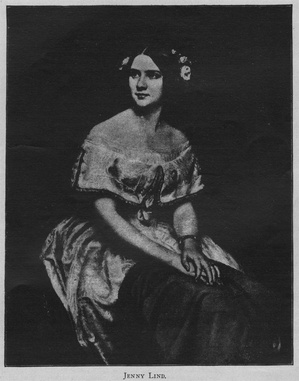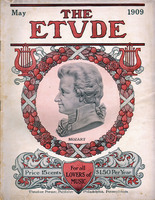The Story of the Teacher of Jenny Lind
An Account of the Most Remarkable Career in the History of Musical Education—How One Man Lived to See a Century of Musical Advance in Which it Was His Privilege to Take an Important Part.
On July 1, 1906, there died in London a man whose honor it was to know personally more of the great composers, singers and performers of the world than it is likely any other musician will ever know. Manuel Garcia in his one hundred and second year closed his career as a teacher, a singer, an author and an inventor. It is unlikely that the world will ever see a similar career. That this man who in 1825-26 had been an important factor in the first real Italian opera season in New York, and had been the teacher of Jenny Lind, should live to congratulate his friend, Charles Klein, upon the success of his play, “The Lion and the Mouse,” which is now touring this country, seems almost beyond belief.
Mr. M. S. Mackinlay, M.A., Oxon., the author of the recently published “Garcia the Centenarian and His Times,” who is himself the last pupil taken by the master, and is the son of Antoinette Sterling, one of Garcia’s best-known American pupils, gives us, in the following quotations, many interesting aspects of the noted teacher’s life.
Seven years before the outbreak of our second war with England and during the Napoleonic invasion with Spain, Manuel Patricio Rodriguez Garcia was born at Zafra, in Catalonia. His family name of Rodriguez had been changed to Garcia by his father, who assumed the latter name as a nom de guerre. Both of his parents were noted opera singers. At the time of his birth Beethoven, Schubert, Auber, Bishop, Burney, Haydn, Cherubini, Halèvy, Meyerbeer, Paganini, Rossini and Spohr were all living, and many of them had yet to become famous. Chopin, Schumann, Mendelssohn and Brahms were not even born. Gounod, Wagner, Verdi and Liszt were still school boys when Garcia was a full-blown operatic baritone. At the time of his birth Garcia’s father was achieving great success with his original mono-drama, “El Poeta Calulista.” Garcia’s sister Maria, who was destined to become Mme. Maria Malibran, one of the most famous of all opera singers, was born in March, 1807.
Part of the master’s youth was spent in Naples, where he was placed under the careful tuition of the famous tenor Ansani, Zingarelli and his own father.
FIRST ITALIAN OPERA IN NEW YORK.
Manuel Garcia’s operatic début was made in New York City on November 29th, 1825. His sister Maria (Mme. Malibran) made her début at the same time. The opera was “II Barbière,” and the company was one which the elder Garcia had brought to America largely through the managerial enterprise of Signor Daponte, who had acquired fame as the librettist of Mozart’s “Don Giovanni” and “Cosi Tau Tutle.” The performances were exceedingly successful, and one interesting incident was the love making of Fitz-Greene Halleck, one of our first American poets, who became an ardent admirer of the little Spanish prima donna “Maria Garcia.” It is fascinating to note the contents of contemporary newspapers, which at that time announced such things as the death of Jefferson and John Adams, the vague possibility of the adaptation of steam to navigation, as well as the death of Czar Alexander I of Russia, the news of which took over two months to reach New York.
Later, the elder Garcia took his company to Mexico and upon the arrival found that all of the scores had been left behind. Nothing dismayed, the impresario showed his ability by sitting down and writing out the entire score of “Don Giovanni” from memory. A later investigation showed that he had made comparative few omissions. Could any of our present-day impresarios perform such a feat? The following is also an indication of the kind of work that was expected of musicians in those days: It was customary in those days for managers to allow their artists nine days to learn a two-act opera. For three acts the time would be increased to twelve days, and for four acts, sixteen. That the elder Garcia did not always allow so much is borne out by the statement which Maria Malibran used to make, that on one occasion her parent bade her learn a rôle in two days and sing it at the opera.
“I cannot do it, father.”
“You will do it, my daughter; and if you fail in any way I shall really strike you with my dagger when I am supposed to kill you on the stage.”
“And he would have done it, too,” she would add, “so I played the part.”
Work of this kind, however, proved such a great strain upon the younger Garcia that his voice was seriously injured. He set out for Paris in 1827 with the hope of repairing this injury and also to meet his sister Maria who, in the meantime, was very unhappily married to M. Malibran, a French merchant three times her own age. He had been thrown into prison for debt and the singer had escaped to Paris. Garcia resolved to devote his time to teaching and after a short time spent as a soldier in the war in Algiers he returned to Paris and commenced his physiological investigations, which resulted in the invention of the laryngoscope.
MALIBRAN’S WONDERFUL SUCCESS.
At the same time Malibran commenced the most remarkable part of her career. Everywhere this wonderful contralto was heralded as the greatest singer of her day. The fees she received were said to have been far in excess of those paid any other singer. In 1836 her marriage with Malibran was annulled and she married the well-known violinist, C. de Beriot. Shortly thereafter she was seriously injured by a fall from a horse and after a few years died at the age of twenty-eight. She was overcome with exhaustion at a concert in England and her last days were spent in a delirium during which she would break out into snatches of songs from her favorite operas.
After the death of Malibran in 1836, Garcia devoted himself to teaching and achieved fame rapidly. His first successful pupil was his sister, Pauline Garcia Viardot. George Sand called her “the personification of poetry and music,” and Alfred de Musset went into veritable raptures over her art. Later, Richard Wagner indicated how thorough the training of Pauline’s brother had been by stating that Mme. Viardot read a whole act of “Tristan and Isolde” at sight. When Bayreuth was founded Wagner invited Garcia to train the leading singers.
Undoubtedly Garcia’s most notable pupil was Jenny Lind. Her wonderful voice had been discovered in her native town of Stockholm by Mlle. Lundberg, a dancer at the Royal Opera House, who heard the child singing to a pet kitten in front of her home. Through faulty instruction her voice was much impaired and when she went to Garcia in 1841 (shortly after he had been appointed professor of singing at the Paris Conservatoire) he at once recognized her wonderful voice notwithstanding the injuries that had been done to it.
Moved by her evident distress, he recommended her to give her voice six weeks of perfect rest—to abstain during the whole of that time from singing even so much as one single note, and to speak as little as possible. Upon condition that she strictly carried out these injunctions he gave her permission to come to him again when the period of probation was ended, in order that he might see whether anything could be done for her. Intense, indeed, must have been the relief when these six weeks had at last expired.
Jenny Lind’s consequent success is now a very conspicuous part of the history of song.
Jenny Lind had the priceless power of taking pains, added to which hers was a glorious voice, properly developed under her master’s tender care. The combination of these gifts, mental and physical, enabled her to overcome every obstacle which crossed her path, and to reach the lofty position which she retained up to the time of her retirement from public life. Her career was the pride of her fellow-countrymen, and the name by which she became known, “the Swedish Nightingale,” constant reminder of her nationality.
MARCHESI AND HER PUPILS.
Among his other famous pupils was Matilde Grauman, now known as Mme. Marchesi, who says of him in “Marchesi and Music:”
“I need scarcely mention how the maestro’s clear, intelligent and thorough method furthered my artistic efforts. His ideas on the female voice and its development were a revelation to me, and they were the foundation of my future career. With Nicolai and Mendelssohn I had only studied classical music; now Garcia initiated me into the style of the Italian school, as at that time a florid execution was the principal aim of all good singers. The compositions of Rossini, Bellini and Donizetti were the chief objects of study and I was obliged, therefore, to work away at countless scales, arpeggios, etc., and what was worse still, with the metronome, which sometimes rendered me almost desperate.”
Through Marchesi, Garcia became the “grand teacher” of her famous pupils—Suzanne Adams, Calvé, Eames, Gerster, Melba, Nevada, Sanderson, Saville and Tremelli.
Other famous pupils Garcia taught personally in Paris were Johanna Wagner (niece of Richard Wagner) and Julius Stockhausen.
In 1848 Garcia went to London and remained in the English capital the rest of his days. In 1848 he was appointed a member of the faculty of the Royal Academy of Music. Among his early London pupils was Stockhausen, who was afterwards to become the teacher of such famous singers as Geo. Henschel and Van Rooy.
In 1854 he invented the “Laryngoscope,” which, although is little more than the combination of the little dental hand mirror with a larger mirror adjusted to reflect a ray of light upon the smaller mirror in the mouth and thus reveal the various organs that had been previously concealed, was destined to have an important bearing upon the physiological study of the throat.
In London, Garcia taught Charles Santley and also Antoinette Sterling. In 1895, with the assistance of Mr. Hermann Klein, now of New York, Garcia wrote and published his “Hints on Singing,” a very unusual work for an octogenarian author.
A REMARKABLE BIRTHDAY
Garcia continued teaching until he was ninety- six years of age, and more remarkable still is the fact that he lost very few lessons from illness during these last years. On his one hundredth birthday, March 17th, 1905, he was received by the King at Buckingham Palace and his Majesty was “absolutely amazed at the vitality he displayed:” Distinctions of every description were showered upon him, including the insignia of Commander of the Royal Victorian Order (English), the Great Gold Medal for Science (conferred by the German Government only upon the most distinguished scientists), Grand Cross of the Order of Alfonso XII (Spanish). Musical and Laryngological societies from all over the world sent representatives, and the entire day was one of the most memorable in the history of both music and surgery.




